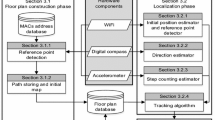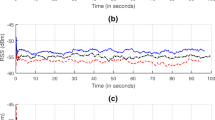Abstract
Nowadays, it is clear that location systems are increasingly present in people’s lives. In general people often spend 80–90 % of their time in indoor environments, which include shopping malls, libraries, airports, universities, schools, offices, factories, hospitals, among others. In these environments, GPS does not work properly, causing inaccurate positioning. Currently, when performing the location of people or objects in indoor environments, no single technology can reproduce the same results achieved by the GPS for outdoor environments. One of the main reasons for this is the high complexity of indoor environments where, unlike outdoor spaces, there is a series of obstacles such as walls, equipment and even people. Thus, it is necessary that the solutions proposed to solve the problem of location in indoor environments take into account the complexity of these environments. In this paper, we propose an adaptable platform for indoor location, which allows the use and combination of different technologies, techniques and methods in this context.
Access this chapter
Tax calculation will be finalised at checkout
Purchases are for personal use only
Similar content being viewed by others
References
Apple. Footprint: Indoor positioning with core location (2015). http://developer.apple.com/library/ios/samplecode/footprint/
Bhide, M., Deolasee, P., Katkar, A., Panchbudhe, A., Ramamritham, K., Shenoy, P.: Adaptive push-pull: disseminating dynamic web data. IEEE Trans. Comput. 51(6), 652–668 (2002)
Google. Indoor maps (2014). http://www.google.com/intl/pt-br/maps/about/partners/indoormaps/
Han, D., Andersen, D.G., Kaminsky, M., Papagiannaki, K., Seshan, S.: Access point localization using local signal strength gradient. In: Moon, S.B., Teixeira, R., Uhlig, S. (eds.) PAM 2009. LNCS, vol. 5448, pp. 99–108. Springer, Heidelberg (2009)
He, J., Wang, Q., Zhan, Q., Liu, B., Yu, Y.: A practical indoor toa ranging error model for localization algorithm. In: 2011 IEEE 22nd International Symposium on Personal Indoor and Mobile Radio Communications (PIMRC), pp. 1182–1186. IEEE (2011)
Hightower, J., Brumitt, B., Borriello, G.: The location stack: a layered model for location in ubiquitous computing. In: Proceedings Fourth IEEE Workshop on Mobile Computing Systems and Applications 2002, pp. 22–28 (2002)
Thomas Konrad, P.W.: Wifi compass wifi access point localization with android devices. Master’s thesis, Information Security program at St. Polten University of Applied Sciences (2012)
Kriens, P., Hargrave, B.: Listeners considered harmful: The whiteboard pattern. Technical whitepaper, OSGi Alliance (2004)
Lemic, F., Handziski, V., Wirstrom, N., Van Haute, T., De Poorter, E., Voigt, T., Wolisz, A.: Web-based platform for evaluation of RF-based indoor localization algorithms. In: 2015 IEEE International Conference on Communication Workshop (ICCW), pp. 834–840 (2015)
Lymberopoulos, D., Giustiniano, D., Lenders, V., Rea, M., Andreas Marcaletti, A., et al.: A realistic evaluation, comparison of indoor location technologies: experiences and lessons learned. In: ACM/IEEE International Conference on Information Processing in Sensor Networks, pp. 178–189 (2015)
Melo, M., Aquino, G.: A taxonomy of technologies for fingerprint-based indoor localization. In: 7o Simpósio Brasileiro de Computao Ubíqua e Pervasiva (SBCUP 2015), pp. 111–120. SBC (2015)
Melo, M., Aquino, G.: Categorization of technologies used for fingerprint-based indoor localization. In: Eleventh International Conference on Systems and Networks Communications 2015. ICSNC 2015, pp. 25–29. IARIA (2015)
MongoDB (2015). https://www.mongodb.org
Najib, W., Klepal, M., Wibowo, S.B.: Mapume: scalable middleware for location aware computing applications. In: 2011 International Conference on Indoor Positioning and Indoor Navigation (IPIN), pp. 1–6, September 2011
Ranganathan, A., Al-Muhtadi, J., Chetan, S.K., Campbell, R., Mickunas, M.D.: MiddleWhere: a middleware for location awareness in ubiquitous computing applications. In: Jacobsen, H.-A. (ed.) Middleware 2004. LNCS, vol. 3231, pp. 397–416. Springer, Heidelberg (2004)
Opus Research. Mapping the indoor marketing opportunity (2015)
Simoni, M., Jaakkola, M.S., Carrozzi, L., Baldacci, S., Di Pede, F., Viegi, G.: Indoor air pollution and respiratory health in the elderly. Eur. Respir. J. 21(40 suppl), 15s–20s (2003)
Stevenson, G., Ye, J., Dobson, S., Nixon, P.: LOC8: a location model and extensible framework for programming with location. IEEE Pervasive Comput. 9(1), 28–37 (2010)
Acknowledgment
This work was partially supported by the National Institute of Science and Technology for Software Engineering (INES) funded by CNPq under grant 573964/2008–4.
Author information
Authors and Affiliations
Corresponding author
Editor information
Editors and Affiliations
Rights and permissions
Copyright information
© 2016 Springer International Publishing Switzerland
About this paper
Cite this paper
Melo, M., Aquino, G., Morais, I. (2016). Indoor Location: An Adaptable Platform. In: Gervasi, O., et al. Computational Science and Its Applications – ICCSA 2016. ICCSA 2016. Lecture Notes in Computer Science(), vol 9787. Springer, Cham. https://doi.org/10.1007/978-3-319-42108-7_15
Download citation
DOI: https://doi.org/10.1007/978-3-319-42108-7_15
Published:
Publisher Name: Springer, Cham
Print ISBN: 978-3-319-42107-0
Online ISBN: 978-3-319-42108-7
eBook Packages: Computer ScienceComputer Science (R0)




